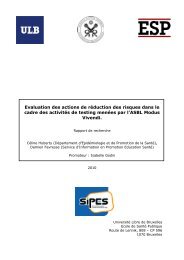Risk assessment of new psychoactive substances - EMCDDA - Europa
Risk assessment of new psychoactive substances - EMCDDA - Europa
Risk assessment of new psychoactive substances - EMCDDA - Europa
- No tags were found...
You also want an ePaper? Increase the reach of your titles
YUMPU automatically turns print PDFs into web optimized ePapers that Google loves.
Annex IISemi-quantitative <strong>assessment</strong> procedureThere are five major domains affecting the extent <strong>of</strong> risk: B (Dependence andabuse potential); C (Prevalence <strong>of</strong> use); D (Health risks); E (Social risks), and F(Involvement <strong>of</strong> organised crime). These five domains are further specified inAnnex I: Technical report. Section A in the technical report is merely descriptiveand does not determine the extent <strong>of</strong> risks associated with the <strong>new</strong> <strong>psychoactive</strong>substance.Four <strong>of</strong> the five domains are divided into subgroups (B.1, B.2, etc.). Each subgroupreceives a score based on expert judgement, taking into account the principles setout in the guidelines. The score obtained for each subgroup is called ‘risk level’(RL). Domain C (Prevalence) receives only a single score.As indicated in Chapter 2.1 <strong>of</strong> the guidelines, risk is to be understood andconsidered in its dual sense: both the degree <strong>of</strong> seriousness <strong>of</strong> harm (hazard) andthe probability <strong>of</strong> harm. The expert is expected to make a judgement <strong>of</strong> the risklevel comprised <strong>of</strong> an integrated <strong>assessment</strong> <strong>of</strong> both hazard and probability. Inthis respect, probability should be judged independently <strong>of</strong> prevalence <strong>of</strong> use,which is assessed separately under C. Thus, probability means the likelihood thata single user will be harmed.Note that assigning scores for the sub-categories <strong>of</strong> the subgroups (i.e. D1.1 andD1.2) is not a requirement, as a panel <strong>of</strong> scientists is apt to give an integral (semi-)quantitative judgement on each subgroup, provided their judgement is embeddedin a Delphi-like environment.The Scientific Committee <strong>of</strong> the <strong>EMCDDA</strong> (if necessary, extended by a further fiveexperts at most, and with up to two experts from the Commission, Europol and theEMEA (Article 6.2)) has the task to produce a report which gives a science-based(semi-)quantitative judgement on all aspects mentioned in the domains B to F.Based on this report, the Scientific Committee gives a final overall judgement <strong>of</strong> therisks <strong>of</strong> the <strong>new</strong> <strong>psychoactive</strong> substance and formulates a conclusion.57







